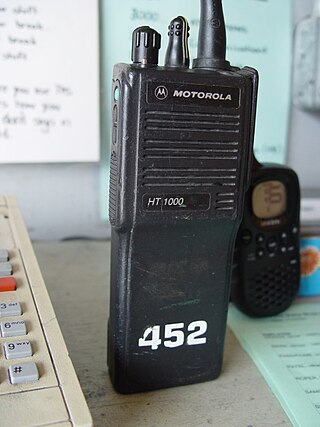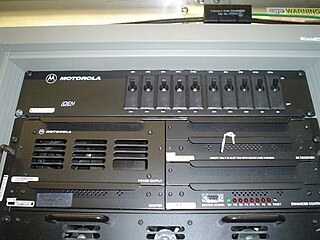Integrated Digital Enhanced Network (iDEN) is a mobile telecommunications technology, developed by Motorola, which provides its users the benefits of a trunked radio and a cellular telephone. It was called the first mobile social network by many technology industry analysts. iDEN places more users in a given spectral space, compared to analog cellular and two-way radio systems, by using speech compression and time-division multiple access (TDMA).
Terrestrial Trunked Radio, a European standard for a trunked radio system, is a professional mobile radio and two-way transceiver specification. TETRA was specifically designed for use by government agencies, emergency services, for public safety networks, rail transport staff for train radios, transport services and the military. TETRA is the European version of trunked radio, similar to Project 25.
Automatic vehicle location is a means for automatically determining and transmitting the geographic location of a vehicle. This vehicle location data, from one or more vehicles, may then be collected by a vehicle tracking system to manage an overview of vehicle travel. As of 2017, GPS technology has reached the point of having the transmitting device be smaller than the size of a human thumb, able to run 6 months or more between battery charges, easy to communicate with smartphones — all for less than $20 USD.

Professional mobile radio are person-to-person two-way radio voice communications systems which use portable, mobile, base station, and dispatch console radios. PMR radio systems are based on such standards as MPT-1327, TETRA, APCO 25, and DMR which are designed for dedicated use by specific organizations, or standards such as NXDN intended for general commercial use. These systems are used by police, fire, ambulance, and emergency services, and by commercial firms such as taxis and delivery services. Most systems are half-duplex, in which multiple radios share a common radio channel, and only one can transmit at a time. Transceivers are normally in receive mode, the user presses a push-to-talk button on his microphone when he wants to talk, which turns on his transmitter and turns off his receiver. They use channels in the VHF and UHF bands, giving them a limited range, usually 3 to 20 miles depending on terrain. Output power is typically limited to 4 watts. Repeaters installed on tall buildings, hills or mountain peaks are used to increase the range of systems.

A two-way radio is a radio transceiver, which is used for bidirectional person-to-person voice communication with other users with similar radios, in contrast to a broadcast receiver, which only receives transmissions.
Project 25 is a suite of standards for interoperable digital two-way radio products. P25 was developed by public safety professionals in North America and has gained acceptance for public safety, security, public service, and commercial applications worldwide. P25 radios are a direct replacement for analog UHF radios, but add the ability to transfer data as well as voice, allowing for more natural implementations of encryption and text messaging. P25 radios are commonly implemented by dispatch organizations, such as police, fire, ambulance and emergency rescue service, using vehicle-mounted radios combined with repeaters and handheld walkie-talkie use.
The Enhanced Digital Access Communication System (EDACS) is a radio communications protocol and product family invented in the General Electric Corporation in the mid 1980s.

A trunked radio system is a two-way radio system that uses a control channel to automatically assign frequency channels to groups of user radios. In a traditional half-duplex land mobile radio system a group of users with mobile and portable two-way radios communicate over a single shared radio channel, with one user at a time talking. These systems typically have access to multiple channels, up to 40-60, so multiple groups in the same area can communicate simultaneously. In a conventional (non-trunked) system, channel selection is done manually; before use the group must decide which channel to use, and manually switch all the radios to that channel. This is an inefficient use of scarce radio channel resources because the user group must have exclusive use of their channel regardless of how much or how little they are transmitting. There is also nothing to prevent multiple groups in the same area from choosing the same channel, causing conflicts and 'cross-talk'. A trunked radio system is an advanced alternative in which the channel selection process is done automatically by a central controller (computer).

A radio repeater is a combination of a radio receiver and a radio transmitter that receives a signal and retransmits it, so that two-way radio signals can cover longer distances. A repeater sited at a high elevation can allow two mobile stations, otherwise out of line-of-sight propagation range of each other, to communicate. Repeaters are found in professional, commercial, and government mobile radio systems and also in amateur radio.
Motorola Type II refers to the second generation Motorola trunked radio systems that replaced fleets and subfleets with the concept of talkgroups and individual radio IDs. There are no dependencies on fleetmaps, therefore there are no limitations on how many radio IDs can participate on a talkgroup. This allows for greater flexibility for the agency. When scanning Motorola IDs, each Type II user ID appears as an even 4- or 5-digit number without a dash.
Motorola Type I Is the original type of Motorola's Trunked radio system; it is based on Fleets and Subfleets. Each system had a certain number of Fleets assigned, and then each Fleet had a certain number of Subfleets and radio IDs. The distribution of Fleets and Subfleets on a Type I system is determined by the system Fleetmap. Motorola Type I systems are not scalable because they limit the amount of IDs any fleet or subfleet can support. Each Type I ID appears as a three or four digit number, followed by a hyphen, followed by a one or two digit number.
A Motorola Type IIi Hybrid system is a type of Trunked radio system that mixes "blocks" of Type I Fleets/Subfleets with Type II talkgroups. In some cases, all radios support Type II, but in some cases, Type I radios might be used exclusively in subfleets while the Type IIs are used exclusively in talkgroups.

Mobile radio or mobiles refer to wireless communications systems and devices which are based on radio frequencies, and where the path of communications is movable on either end. There are a variety of views about what constitutes mobile equipment. For US licensing purposes, mobiles may include hand-carried,, equipment. An obsolete term is radiophone.
LTR MultiNet Systems are APCO-16 compliant LTR Trunked Radio Systems and thus are mostly found in use as public safety systems. LTR MultiNet systems usually have one or more "status channels" that act like a control channel in a Motorola or EDACS system, however these channels can also carry voice transmissions simultaneously.
In a conventional, analog two-way radio system, a standard radio has noise squelch or carrier squelch, which allows a radio to receive all transmissions. Selective calling is used to address a subset of all two-way radios on a single radio frequency channel. Where more than one user is on the same channel, selective calling can address a subset of all receivers or can direct a call to a single radio. Selective calling features fit into two major categories—individual calling and group calling. Individual calls generally have longer time-constants: it takes more air-time to call an individual radio unit than to call a large group of radios.
Specialized Mobile Radio (SMR) may be an analog or digital trunked two-way radio system, operated by a service in the VHF, 220, UHF, 700, 800 or 900 MHz bands. Some systems with advanced features are referred to as an Enhanced Specialized Mobile Radio (ESMR). Specialized Mobile Radio is a term defined in US Federal Communications Commission (FCC) regulations. The term is of US regulatory origin but may be used in other regions to describe similar commercial systems which offer a radio communications service to businesses.
ASTRO 25 is the next generation of ASTRO digital two-way radio communications by Motorola Solutions. Motorola first introduced digital two-way radio in the U.S. in 1991 under the name ASTRO Digital Solutions.

NXDN stands for Next Generation Digital Narrowband, and is an open standard for public land mobile radio systems; that is, systems of two-way radios (transceivers) for bidirectional person-to-person voice communication. It was developed jointly by Icom Incorporated and Kenwood Corporation as an advanced digital system using FSK modulation that supports encrypted transmission and data as well as voice transmission. Like other land mobile systems, NXDN systems use the VHF and UHF frequency bands. It is also used as a niche mode in amateur radio.
Digital mobile radio (DMR) is a digital radio standard for voice and data transmission in non-public radio networks. It was created by the European Telecommunications Standards Institute (ETSI), and is designed to be low-cost and easy to use. DMR, along with P25 phase II and NXDN are the main competitor technologies in achieving 6.25 kHz equivalent bandwidth using the proprietary AMBE+2 vocoder. DMR and P25 II both use two-slot TDMA in a 12.5 kHz channel, while NXDN uses discrete 6.25 kHz channels using frequency division and TETRA uses a four-slot TDMA in a 25 kHz channel.





